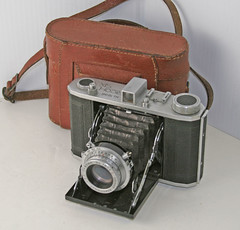Ricoh Six
The Ricoh Six is a Japanese 6×6 folder. It was made from 1952,[1] by Riken's subsidiary Asahi Seimitsu, which was in charge of camera development at the time, before it was merged in 1953 into its parent company Riken Kōgaku Kōgyō.
Description
The Ricoh Six is a horizontal folding camera. The folding struts are inspired by the Ikonta. The top plate has a chrome finish, with the tubular optical finder in the middle. The advance knob, placed at the left end, has two arrows to indicate the winding direction and a round piece of leather. On the left of the finder, there is an accessory shoe and a button to release the folding bed. There is a body release and a leather-covered film retaining flange at the right end of the top plate. The name RICOH SIX and the serial number are engraved to the right of the finder. The name is repeated on the leatherette covering of the front door.
The camera can take 6×6 or 4.5×6 pictures with an exposure mask. The back is hinged to the right and contains two red windows placed in the middle, one above the other. They are protected by sliding covers, engraved 4.5X6 and 6X6. Indications of the format (6×6 or 4.5×6) are also embossed in the leatherette covering, under the levers controlling the red window covers.
The lens is a three-element C. Orinar Anastigmat 80mm f/3.5.[2] The shutter gives B, 25, 50, 100 speeds and is engraved RIKEN at the bottom of the speed rim. It is synchronized via an ASA bayonet post and has a distant release connection.
 
|
| Ricoh Six no.1696, C. Orinar Anastigmat 80mm f/3.5 lens no.1804. Pictures courtesy of Jay Tepper. (Image rights) |
Production
The Ricoh Six was featured in a column of the May 1952 issue of Asahi Camera.[3] This article reportedly mentions a Ricoh 80/3.5 lens, but this lens name has not been observed so far.[4]
Some sources say that the camera body was bought from a sub-contractor.[5] The lens was made by Fujita Kōgaku[6] and the Riken shutter was the same as mounted on the Ricohflex III, IV, VI and VII.
The Ricoh Six was mainly sold in the PX shops of the occupying American army in Japan.[7] It is said that it cost ¥6,800.[8] It seems more common in the USA than in Japan.
All the examples observed so far are identical. The known serial numbers have four digits in the 1xxx and 2xxx range (lowest is 1118, highest is 2953), in a sequence probably starting at 1001. The numbers on the Orinar lenses are more or less in the same range (lowest is 1185, highest is 3731). The total production was probably around 2,000 or 3,000 units.
Notes
- ↑ Kokusan kamera no rekishi, p.372, mentions a May 1952 article about the camera. The release year is given as 1952 in Sugiyama, item 1413, and in McKeown, p.831. It is given as 1953 by mistake in "Rikō 6", p.45 of Kurashikku Kamera Senka no.14, and in this page of the Ricoh website.
- ↑ Three elements: this page of the Ricoh website.
- ↑ Kokusan kamera no rekishi, p.372.
- ↑ Ricoh 80/3.5 lens: Kokusan kamera no rekishi, p.372, certainly after the May 1952 article in Asahi Camera.
- ↑ "Rikō 6", p.45 of Kurashikku Kamera Senka no.14, see also this page of the Ricoh website.
- ↑ This page of the Ricoh website.
- ↑ "Rikō 6", p.45 of Kurashikku Kamera Senka no.14.
- ↑ "Rikō 6", p.45 of Kurashikku Kamera Senka no.14, and this page of the Ricoh website.
Bibliography
- Asahi Camera (アサヒカメラ) editorial staff. Shōwa 10–40nen kōkoku ni miru kokusan kamera no rekishi (昭和10–40年広告にみる国産カメラの歴史, Japanese camera history as seen in advertisements, 1935–1965). Tokyo: Asahi Shinbunsha, 1994. ISBN 4-02-330312-7. Item 1001. (This book shows no advertisement for the Ricoh Six.)
- McKeown, James M. and Joan C. McKeown's Price Guide to Antique and Classic Cameras, 12th Edition, 2005-2006. USA, Centennial Photo Service, 2004. ISBN 0-931838-40-1 (hardcover). ISBN 0-931838-41-X (softcover). P.831.
- "Rikō 6" (リコー6, Ricoh Six) Kamera Rebyū: Kurashikku Kamera Senka (カメラレビュー クラシックカメラ専科) / Camera Review: All about Historical Cameras no.14, October 1989. No ISBN number. Rikō kamera no subete (リコーカメラのすべて, special issue on Ricoh). P.45.
- Sugiyama, Kōichi (杉山浩一); Naoi, Hiroaki (直井浩明); Bullock, John R. The Collector's Guide to Japanese Cameras. 国産カメラ図鑑 (Kokusan kamera zukan). Tokyo: Asahi Sonorama, 1985. ISBN 4-257-03187-5. Item 1413.
Links
In English:
- Ricoh Six in a photo.net post
- Ricoh Six at medfmt
- Ricoh Six at butkus.org
- Folding cameras at Nekosan's website (archived), with a Ricoh Six
- Ricoh Six at Random Camera Blog
In French:
In Japanese:
- Ricoh Six in the Ricoh camera list at the Ricoh official website (picture copied in this page of the Kitamura Camera Museum, with wrong specifications)
- Ricoh Six in the All Japan Classic Camera Club site
